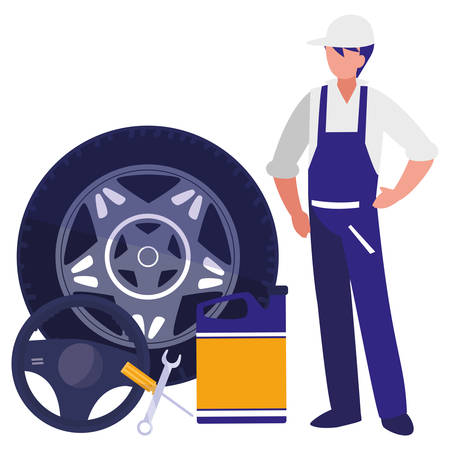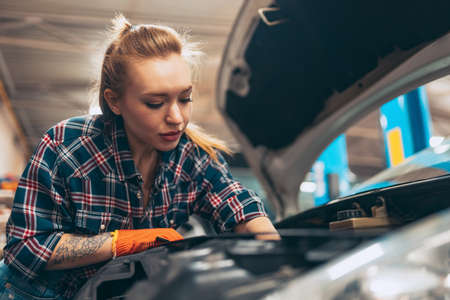Importance of Regular Car Servicing for Women
In India, where road conditions can be unpredictable and traffic is often chaotic, regular car servicing is not just a recommendation—its a necessity. For women drivers, prioritising timely car maintenance is crucial for ensuring both safety and reliability on the road. Well-maintained vehicles are less likely to break down unexpectedly, which is especially important when driving alone or at night. Regular servicing helps in identifying potential issues before they become major problems, reducing the chances of getting stranded in unfamiliar areas. Moreover, understanding and participating in your vehicle’s upkeep empowers you as a woman driver, boosting your confidence to handle any situation that might arise on Indian roads. By staying proactive with car care, you take control of your mobility and independence, making every journey safer and more comfortable.
Essential Car Maintenance Checks to Know
Understanding basic car maintenance is crucial for every woman driver in India, especially with varied road conditions and weather. Regular checks not only ensure your safety but also help you avoid unexpected breakdowns and expensive repairs. Here are some essential maintenance tasks that are simple and beginner-friendly:
1. Checking Engine Oil
Engine oil keeps your car’s engine running smoothly. It is recommended to check the oil level at least once a month or before long trips. To do this, park on a level surface, turn off the engine, wait for it to cool, then pull out the dipstick, wipe it clean, dip it back in fully, and check the oil level. The oil should be between the ‘Min’ and ‘Max’ marks. If it’s low, top up using the right grade of oil as per your car manual.
2. Tyre Pressure & Condition
Maintaining proper tyre pressure is vital for safety and fuel efficiency, especially given India’s diverse road surfaces. Check tyre pressure every two weeks or before long drives. You can find the recommended pressure in your car’s manual or on a sticker inside the driver’s door. Over- or under-inflated tyres can lead to poor handling or blowouts. Also, inspect tyres for wear, cuts, or stones stuck in the treads.
| Check | How Often | Tips for Women Drivers |
|---|---|---|
| Tyre Pressure | Every 2 weeks | Use digital gauges for easy reading; many petrol pumps have free air stations. |
| Tyre Tread & Condition | Monthly | If unsure, ask a trusted mechanic or use a coin to check tread depth. |
3. Coolant Level
The coolant prevents your engine from overheating, which is common during Indian summers or in city traffic jams. Check the coolant level when the engine is cool by looking at the markings on the side of the reservoir tank. If it’s below the minimum mark, add more coolant mixed with water as per your manufacturer’s guidelines.
4. Brake Fluid Check
Your brakes are your most critical safety feature. Ensure brake fluid levels are between the ‘Min’ and ‘Max’ lines on the brake fluid reservoir under the bonnet. Low levels can indicate worn-out brake pads or leaks – both need immediate attention from a mechanic.
Quick Reference Table: Essential Fluids
| Fluid Type | How to Check | When to Top Up/Change |
|---|---|---|
| Engine Oil | Dipstick method | If below minimum mark or as per service schedule (usually every 10,000 km) |
| Coolant | Reservoir markings | If below minimum mark; replace as per manual (typically every 2 years) |
| Brake Fluid | Reservoir markings | If below minimum mark; change every 2 years or as needed |
Tip for Indian Women Drivers:
If you ever feel uncomfortable performing these checks alone, don’t hesitate to ask a trusted family member or visit a reliable local mechanic – it’s always better to be safe than sorry!

3. How to Choose a Trustworthy Service Centre
When it comes to car servicing in India, selecting the right service centre is crucial for both safety and peace of mind, especially for women drivers. Start by looking for authorised service centres linked to your car brand, such as Maruti Suzuki, Hyundai, or Tata Motors. These centres use genuine spare parts and have trained mechanics familiar with your vehicle. If you prefer local garages, check Google reviews, ask friends or neighbours (especially other women drivers), and look out for workshops that display certifications or tie-ups with popular insurance companies.
In recent years, many Indian cities have seen the rise of women-friendly service centres. These places offer female staff, separate waiting areas for women, and sometimes even special discounts or training sessions on car maintenance. Use online platforms like GoMechanic, Carpathy, or even city-specific Facebook groups to find such recommendations.
Cultural Tips for Interacting with Mechanics
When visiting a service centre or local garage, remember that clear communication helps avoid misunderstandings. Be confident, make eye contact, and don’t hesitate to ask questions about the work being done or request an estimate before starting repairs. It’s common in India to bring along a trusted male family member or friend if you’re unsure—but this isn’t mandatory. Many urban workshops are becoming more inclusive and respectful towards women customers.
Always collect a bill after service and keep all records safe for future reference. If you ever feel uncomfortable or sense that you’re not being treated fairly, don’t hesitate to walk away and try another centre. Respectful behaviour is expected from both sides, so politeness combined with assertiveness goes a long way in ensuring a smooth experience at any Indian garage.
4. Dealing with Common Car Troubles on Indian Roads
As a woman driver in India, facing car troubles like sudden breakdowns, flat tyres, or starting issues can be stressful, especially if you’re travelling alone or at odd hours. However, knowing a few simple troubleshooting steps and being aware of trusted roadside assistance services can make all the difference. Here’s how you can handle common situations confidently and safely on Indian roads:
Common Car Problems & Quick Solutions
| Issue | What to Do | Extra Tips |
|---|---|---|
| Car Won’t Start | Check if the battery is dead by turning on headlights/horn. If it’s not working, battery may be the issue. Try jump-starting if you have cables and know how; else call for help. | Always keep your phone charged and save helpline numbers. |
| Flat Tyre (Puncture) | Park at a safe spot, turn on hazard lights. Use your toolkit to change the tyre if confident. Otherwise, call roadside assistance. | Practice changing a tyre at home; keep a portable air pump. |
| Engine Overheating | If you see steam from the bonnet or temperature gauge is high, stop immediately and let the engine cool. Do not open radiator cap when hot. Call for assistance if unsure. | Carry extra coolant/water in your boot. |
| Breakdown (Unknown Reason) | Move vehicle to the side, turn on hazard lights, and stay inside with doors locked while you seek help. | Avoid accepting unsolicited help from strangers; wait for professional support. |
Important Helplines & Roadside Assistance Services in India
Many car manufacturers and insurance companies offer round-the-clock roadside assistance across India. Here are some reliable options you should keep handy:
| Service Provider | Helpline Number | Key Features |
|---|---|---|
| Maruti Suzuki On Road Service (MOS) | 1800 102 1800 / 1800 1800 180 | PAN-India coverage, towing, minor repairs, battery jumpstart |
| Hyundai Roadside Assistance | 1800 102 4645 / 0124-4343937 | Towing, tyre change, fuel delivery, battery support |
| Apollo Munich/ICICI Lombard Insurance RSA | Check policy card/app for direct number | 24×7 support linked to insurance policy coverage |
| AAM India (Automobile Association of India) | 022-22041016 / Visit local branch website for regional numbers | PAN-India membership-based emergency service network |
| Mumbai Traffic Police Helpline (for emergencies) | 100 / 103 / 8454999999 (WhatsApp) | Civic emergency help for Mumbai region drivers |
Useful Local Apps & Services for Women Drivers
- SOS Apps: Download apps like Sheroes Safety App, Himmat Plus (Delhi), My Safetipin, which provide location tracking and emergency alerts specifically for women.
- NCRB Emergency Number: Dial 112 for all-India police/fire/ambulance emergencies.
Cultural Tip:
- SOS Apps: Download apps like Sheroes Safety App, Himmat Plus (Delhi), My Safetipin, which provide location tracking and emergency alerts specifically for women.
- NCRB Emergency Number: Dial 112 for all-India police/fire/ambulance emergencies.
Cultural Tip:
If you feel unsafe while waiting for help—especially at night or in remote areas—contact family or friends to inform them of your location. In many Indian cities, female-friendly taxi/rideshare services like Sakhi Cab, Pink Cabs, or Mahalaxmi Women Taxi can also come to your aid if needed.
The key is to stay calm and prepared: keep essential helpline numbers saved in your phone, carry a basic toolkit, and familiarise yourself with these steps before hitting the road. This approach ensures that you stay safe and independent wherever your journey takes you in India!
5. Women-Specific Safety Tips During Car Servicing
When it comes to car servicing and maintenance, safety is always a top priority, especially for women drivers in India. The following strategies are designed to help you stay safe while waiting at service centres, travelling alone, or facing emergency situations. These tips consider the unique social context and cultural norms of India, ensuring your experience is both secure and comfortable.
Stay Alert and Choose Service Centres Wisely
Select authorised or well-reviewed service centres located in busy areas. Before leaving your car, observe the surroundings and avoid isolated locations. Always inform a family member or friend about your whereabouts and estimated time for the service.
Keep Emergency Contacts Handy
Always save local emergency helpline numbers like 100 (police) and 112 (all-in-one emergency) on your phone. Consider installing safety apps such as Himmat or My Safetipin that are popular among Indian women for added security.
Trust Your Instincts and Set Boundaries
If you feel uncomfortable with any interaction—be it with staff or other customers—politely but firmly set boundaries. Do not hesitate to ask for another staff member or request that your car be serviced in your presence if possible.
While Waiting at Service Centres
Sit in designated waiting areas where there are other people present. Carry a book, headphones, or work to keep yourself occupied so you appear confident and less approachable by strangers. Avoid sharing personal details with anyone except official staff.
Travelling Alone for Servicing
If possible, schedule appointments during daylight hours. If you need to use public transport or cabs, share your live location with trusted contacts via WhatsApp or similar apps. Always double-check cab details before boarding and prefer rides with female drivers when available.
Handling Emergency Situations
If you face a breakdown or an unexpected issue en route to the service centre, stay inside your locked vehicle while calling for roadside assistance. Only open the door for uniformed personnel from reputed organisations or those whose identity you can verify. Avoid accepting unsolicited help from strangers, especially at night or in less populated areas.
Key Takeaway for Indian Women Drivers
Your safety is paramount—being prepared and aware helps you handle any situation confidently. By following these India-specific tips, you can make every car servicing experience safe, smooth, and stress-free.
6. Cost Management and Negotiation Tips
Maintaining your car doesn’t have to be a costly affair if you plan smartly and negotiate confidently. Here are some India-specific tips for women drivers to effectively manage their car servicing expenses:
Budgeting for Servicing
Always set aside a yearly budget for your car’s maintenance based on the manufacturer’s service schedule. Factor in routine expenses like oil changes, brake pad replacements, and filter changes. If you own popular models like Maruti Suzuki, Hyundai, or Tata, research average service costs in your city—these are often discussed in local WhatsApp groups or on online forums such as Team-BHP.
Checking Estimates
Before agreeing to any work, always ask the service advisor for a detailed estimate. In India, it’s common practice to receive a “job card” with itemized pricing at authorized workshops. Cross-check these prices online or with friends who own similar cars. Don’t hesitate to request clarification for any unfamiliar charges; transparency is your right as a customer.
Negotiating Service Costs
Negotiation is part of Indian culture—even in workshops! If you feel the quote is high, politely ask for discounts on labour charges or look out for special offers during festive seasons like Diwali or Holi. Some workshops provide value-added packages (e.g., free pick-up/drop-off, washing) that can save money in the long run. If you’re servicing outside warranty at a trusted local garage, get quotes from 2-3 places before deciding.
Extra Tips Just for Women Drivers
- If you’re unsure about technical terms or recommendations, bring along a friend or relative who knows cars, especially during your first visits.
- Many cities now have women-friendly workshops with female staff or dedicated women’s service days—take advantage of these!
Smart Practices
- Keep all invoices and service records safely; this helps if you need warranty claims or when selling your car.
- Avoid unnecessary add-ons like engine flushes or AC disinfectants unless genuinely needed—ask why they’re being suggested.
By following these simple yet effective tips, you’ll not only save money but also gain confidence each time you visit an Indian workshop. Remember: Knowledge is power—and negotiation is tradition!


